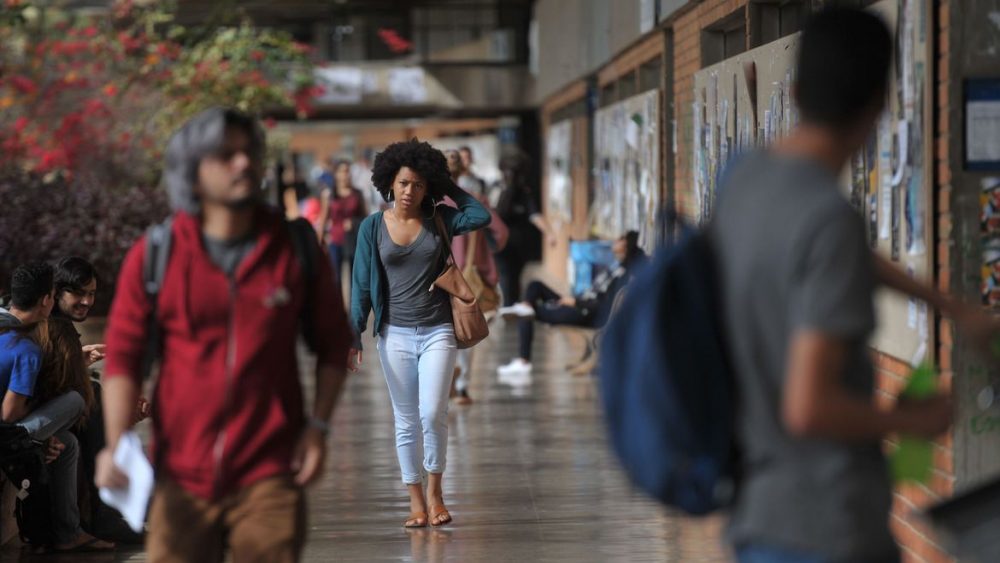RIO DE JANEIRO, BRAZIL – University student Luiza Ventura Lima, from Duque de Caxias, a city in the Rio de Janeiro metropolitan area, is waiting for the end of this semester to graduate in journalism at the Rio de Janeiro University Center, a private institution located in the Méier neighborhood of Rio.
Luíza is black, her parents do not have a college degree, nor do her grandparents. With her diploma almost in hand, she recalls her first day at school. “When I entered university my class had about seventy students. There were only two other black students, and myself,” she recalls.

In her four years in university, Luiza had no black teachers, but she remembers being served by black or mixed-race administrative and supervisory staff, in addition to the cleaning staff. “It makes you stop and think,” she says. She will complete the program at 21, within the age range expected for students who entered higher education with no age or grade lag, nor had to take a semester off.
According to researcher Tatiana Dias Silva, author of a study on affirmative action and black population in higher education, published in August by the Institute of Applied Economic Research (IPEA), 36 percent of young whites in that age group are either studying or have graduated. Among blacks and mixed-race students, this rate drops by half: 18 percent. Target 12 of the National Education Plan (Law 13.005/2014) provides that 33 percent of the population between 18 and 24 years of age should be either taking a course or graduating from university by 2024.
The expert is concerned that inequality will persist for a long time and impact the development of the country. “As a society this is inadmissible. If the racial issue is a structural element, it needs to be addressed. How can we think of the country’s development project unless it incorporates this development for all groups?”, she asks.
From the National Continuous Household Sample Survey (Continuous PNAD) database, of the Brazilian Institute of Geography and Statistics (IBGE), Tatiana Silva’s study estimates that in 2017, 22.9 percent of whites over 25 years of age had completed college education. The proportion of blacks with the same education was 9.3 percent.
A 400 percent increase
Another survey, also based on IBGE data, conducted by the Quero Bolsa [“I want a scholarship”] website, reports that between 2010 and 2019 the number of black students in higher education grew by almost 400 percent. Blacks reached 38.15 percent of the total number of enrolled students, a percentage still below its representation in the population as a whole – 56 percent.
The website also notes that, in some academic disciplines, the presence of blacks does not reach 30 percent. This is observed in medicine, graphic design, advertising and marketing, international relations and chemical engineering.
Lucas Gomes, director of Higher Education at Quero Bolsa, points out the importance of the federal university quota policy (Law 12.711/2012), the access to financing programs (University for All Program, PROUNI, and the Student Financing Program, FIES) and distance education for the growth in the number of black university students over the past decade. He is optimistic. “The trend is that in future generations this will become closer to reality,” he expects.
Outside leadership positions
However, the director points out that, in addition to training more black people, the labor market needs to hire more blacks and mixed-race individuals after university. “We still have a hiring abyss between white and black people”, he warns. “The latest survey conducted by Quero Bolsa, based on data from the CAGED [General Registry of Employed and Unemployed], shows that only two out of ten professionals in leadership positions in private companies were black in 2018.
“In the first six months this year, out of 42,000 leadership positions open in private companies, only 23.7 percent were filled by black men and women. The remainder was filled by whites, other ethnic groups or those who did not declare race,” adds Lucas Gomes.
Diversity specialist Carlos Paes adds that the progress in the labor market still poses greater obstacles for black people. “We have raised other obstacles besides higher education, like speaking another language (English)”. In his opinion, employment in good positions has not increased in the same proportion. “We still see black and poor people in jobs that do not match their qualifications,” he says.
Symbolic effect
Access to better jobs has an impact on income, the chance of social ascension and, for many, access to the middle class. The increase in status still has a symbolic and lasting effect: it opens new perspectives for black children and broadens the worldview of non black children, as Janine Rodrigues, educator, author and founder of ‘Piraporiando’, who works with education for diversity, points out.
“It’s important”, she believes, because it demonstrates the potential for blacks and mixed-race individuals to occupy all social spaces. According to the educator, “when children see blacks everywhere in society, they also build the perception of power.”
Janine Rodrigues points out that institutional racism and social interactions have perverse effects. “Recently a father told me that his son was racist towards a school colleague. But that he, as a father, did not know what to say, because his son was only five years old, and to talk about racism with a five-year-old was very hard,” she says.
“Well, if the five-year-old son can’t hear about racism, is the little schoolgirl of the same age forced to suffer racism and be mature about it? I asked. That’s what racism does. It dehumanizes.”
According to the educator, another effect of racism is to limit knowledge, reduce awareness and feed social exclusion. “Our academia, our schools, our perspective on culture (or its hierarchization) still have a Eurocentic approach. So whatever represents blacks, black culture, is not embedded. Society is always talking about us as ‘the others’. All of this reflects on the perceptions of black children,” she warns.
Source: Agência Brasil

